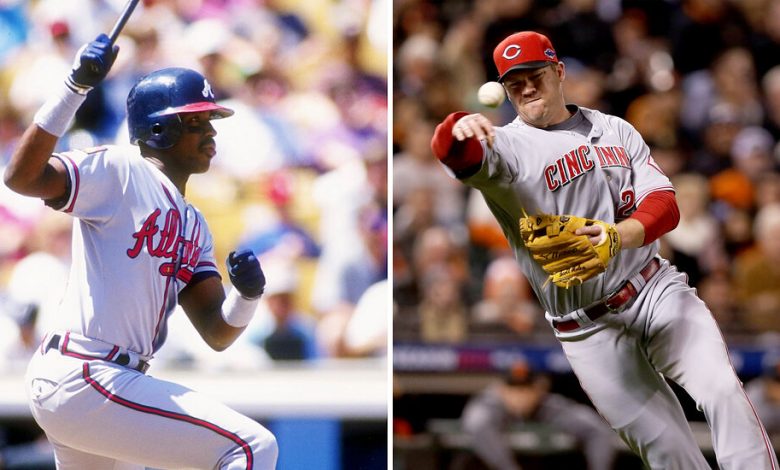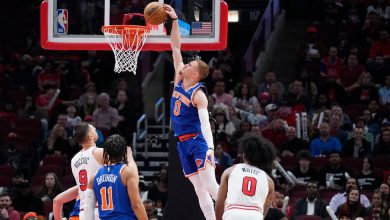‘You Knew Who the Hall of Famers Were’

Sometimes, a new Hall of Fame class fits neatly together in baseball history. Jimmie Foxx and Mel Ott, 500-homer sluggers in the shadow of Babe Ruth, went in together in 1951. Johnny Bench and Carl Yastrzemski, one-city institutions who met in a sublime World Series, took their turn in 1989. Reggie Jackson, an incomparable showman, had the stage to himself in 1993.
This Sunday belongs to Fred McGriff and Scott Rolen, standouts from opposite corners of the diamond whose careers overlapped in the late 1990s and early 2000s. Both played for at least four franchises and made at least five All-Star teams. Both reached the World Series twice, winning once. Neither came close to a Most Valuable Player Award.
Those are loose connections, at best. More than anything else, the pairing of McGriff and Rolen is a powerful reflection of the changing standards for baseball’s highest honor.
McGriff was elected unanimously last December by a 16-person panel called the Contemporary Baseball Era Players Committee. He had previously spent the maximum 10 years on the writers’ ballot, never amassing even a quarter of the vote until his final appearance, in 2019, when he peaked at 39.8 percent — far from the Hall’s threshold of 75.
For McGriff, the discouraging ballot reveal was an exhausting rite of winter.
“We’ve got some tough writers, some tough cookies,” McGriff said, laughing, on a video call with reporters last week. “But it’s tough, because every year your name is on the ballot and you’re coming up, you have people on the outside, your friends and buddies and everybody’s calling. Come January it’s like, ‘Uh-oh, here we go again.’”
Rolen had a far different experience, building support annually among writers and making it on his sixth try. In his debut appearance, on the 2018 ballot, Rolen got just 10.2 percent, with a mere 43 votes among the 422 ballots cast. By this year’s ballot, he had soared to 76.3 percent, with 297 of the 389 writers checking his name.
He still cannot believe it.
“For me to sit here and say, ‘Oh, yeah, me and Ty Cobb and Babe Ruth and Hank Aaron,’ I mean, that’s not real,” Rolen said last week. “That’s not a real situation. These guys are true legends, and I get a chance to share that gallery with them, which I’m greatly honored.”
For some fans, the Hall of Fame should be reserved for only the very best; the comments toward McGriff and Rolen were decidedly unkind when Major League Baseball saluted them in a January tweet.
The reality, though, is that many fans would be unfamiliar with at least half of the Hall’s 342 members. The room would be quite snug if Cobb, Ruth and Aaron were the standard. Membership in the Hall reflects the attitude of voters at the time, and this class shows how rapidly those attitudes are changing.
Part of the reason for McGriff’s low support and Rolen’s sudden surge is logistics; writers are limited to 10 selections, and superstars with ties to steroids (Barry Bonds, Roger Clemens and others) created a logjam on the ballot that only recently eased. But with the electorate becoming younger and different metrics rising in popularity, the old keys to entry no longer unlock the Hall’s door.
Consider McGriff, who said that he sought every year to hit 30 homers, drive in 100 runs and hit as close to .300 as possible. Those were the bedrock statistics in baseball for generations.
“You set goals for yourself every year trying to hit home runs, R.B.I.s, because back in the day, R.B.I.s and batting average were important,” McGriff said. “It’s a little different now, but it was important back in the day. And so you constantly had goals.”
McGriff hit .284 with 493 home runs and 1,550 runs batted in. Only nine players who made their debuts before him matched all of those statistics: Ruth, Lou Gehrig, Foxx, Ott, Ted Williams, Willie Mays, Aaron, Frank Robinson and Eddie Murray. All of them (except Ott, incredibly) were elected to the Hall on the first ballot.
“I always go back to Joe Morgan and how we spoke in Cincinnati,” Rolen said, referring to the Reds’ Hall of Fame second baseman. “I credit him for this statement but I like to use it quite a bit because it’s exactly how I feel: As a player, you knew who the Hall of Famers were that you were playing with and against every day in your era. And so — not any criticism to the writers or the process of any kind — but I always believed Fred McGriff was a Hall of Famer.”
McGriff played 422 more games than Rolen, so he naturally hit more home runs and drove in more runs (Rolen had 316 homers and 1,287 runs batted in). But he also has a higher batting average than Rolen, who hit .281, and also tops him in both on-base percentage (.377 to .364) and slugging percentage (.509 to .490).
What he doesn’t have is Rolen’s overall value, as measured by wins above replacement at Baseball Reference: 70.1 for Rolen, 52.6 for McGriff. Context and a more well-rounded skill set help explain the difference.
Rolen earned eight Gold Gloves and McGriff earned none. Rolen also ranks among his era’s premier hitters at third base, which remains the least represented position in the Hall, with 16 members. There are 26 Hall of Fame first basemen, and sluggers are more common at that spot. This was especially true during McGriff’s prime — though some, like Jason Giambi, Mark McGwire, Rafael Palmeiro and Mo Vaughn, were documented steroid users.
That scandal never ensnared McGriff, who had 10 seasons of at least 30 homers but never hit more than 37. He has often been cited as a clean slugger in a juiced era.
“I took it as a compliment, having integrity and going out and playing the game the way it should be played,” McGriff said.
McGriff’s induction is a victory for the traditional statistics he was expected to produce — and did. Rolen’s is a win for a more nuanced definition of greatness, increasingly valued by front offices, players and the news media.
“The people we watch every day that are talking about the game on MLB Network, they’re slowly shifting that understanding,” said Arizona Diamondbacks third baseman Evan Longoria, who has more career WAR (58.9) than Hall of Famers like Willie Stargell, Hank Greenberg and David Ortiz.
“To the average fan, there’s not really a concrete sense of how a guy really impacts the game. I don’t think there’s enough casual baseball fans that understand the value of O.P.S. and WAR and all those advanced metrics. They’re just going off the batting average, like: ‘Why the heck is this guy making $100 million when he’s hitting .240?’ But if you look at his WAR, he gets on, he steals a base, he plays good defense, he impacts the game in a lot of different ways.”
The Hall of Fame is all about impact, and there is more than one way to evaluate that. McGriff represents the old school and Rolen the new, but the diploma looks the same either way.



